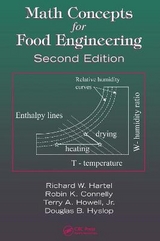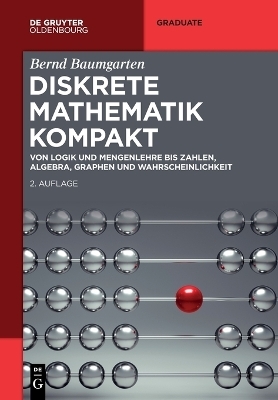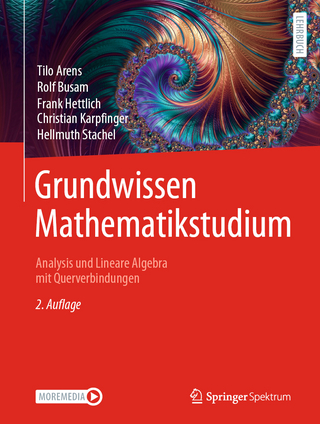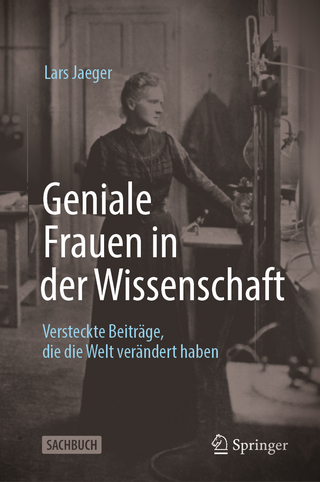
Math Concepts for Food Engineering
Seiten
1997
Technomic Publishing Co (Verlag)
978-1-56676-564-0 (ISBN)
Technomic Publishing Co (Verlag)
978-1-56676-564-0 (ISBN)
- Titel erscheint in neuer Auflage
- Artikel merken
Zu diesem Artikel existiert eine Nachauflage
Offers a review of required basic mathematical methods and relates them to specific areas of food industry problem solving. Prepared for undergraduates in food science programs, this handbook also aids food industry technical personnel and non-technical managers who seek an introduction to food engineering math and problem solving.
Food industry managers, engineers, and scientists require a personal repertory of mathematical tools to find solutions to a variety of work problems. These problems relate to processing, research, analysis, and other operations that require mathematical solutions.
This new handbook provides a practical review of required basic mathematical methods, and relates them to specific areas of food industry problem solving. Prepared for students in undergraduate food science programs, the handbook also serves the needs of food industry technical personnel who would be helped by a review of basic math for food engineering and non-technical managers who seek an introduction to food engineering math and problem solving.
Each chapter on a math or problem-solving skill begins with fundamental concepts, presents step-by-step procedures in the skill, and provides numerous practical, illustrative examples. Practice problems with answers in the appendix provide for self-testing and reinforcement of learning. All of the math skills presented relate to common food industry problems.
From the text
In food engineering, and any other mathematically oriented discipline, one must become adept at problem solving using equations and mathematical principles. Many of the problems that food scientists and engineers face require the ability to apply physical and mathematical principles to solve equations and calculate necessary information. Thus, problem-solving abilities are extremely important, and we should be familiar with the general steps in problem solving.
Food industry managers, engineers, and scientists require a personal repertory of mathematical tools to find solutions to a variety of work problems. These problems relate to processing, research, analysis, and other operations that require mathematical solutions.
This new handbook provides a practical review of required basic mathematical methods, and relates them to specific areas of food industry problem solving. Prepared for students in undergraduate food science programs, the handbook also serves the needs of food industry technical personnel who would be helped by a review of basic math for food engineering and non-technical managers who seek an introduction to food engineering math and problem solving.
Each chapter on a math or problem-solving skill begins with fundamental concepts, presents step-by-step procedures in the skill, and provides numerous practical, illustrative examples. Practice problems with answers in the appendix provide for self-testing and reinforcement of learning. All of the math skills presented relate to common food industry problems.
From the text
In food engineering, and any other mathematically oriented discipline, one must become adept at problem solving using equations and mathematical principles. Many of the problems that food scientists and engineers face require the ability to apply physical and mathematical principles to solve equations and calculate necessary information. Thus, problem-solving abilities are extremely important, and we should be familiar with the general steps in problem solving.
Preface
1.Algebra
- Variables and Constants - Equations - Linear and Nonlinear Equations - Multiple Linear Equations
2.Interpolation of Data in Tables
- Single Interpolations - Double Interpolations
3.Graphs and Curve Fitting
- Coordinate Systems - Linear Graphs - Logarithmic Transformations
4.Calculus
- Differentiation - Integration - Differential Equations
5.Problem Solving
6.Gases and Vapors
- Thermodynamics - Psychometrics
7.Mass Balances
- Steady-state Mass Balances - Unsteady-state Mass Balances
8.Energy Balances
9.Fluid Mechanics
- Rheology - Fluid Flow
10.Heat Transfer
- Steady State - Unsteady-state Heat Transfer - Freezing - Radiation Heat Transfer
Appendix: Answers to Practice Problems
Index
| Erscheint lt. Verlag | 19.5.1997 |
|---|---|
| Verlagsort | Lancaster |
| Sprache | englisch |
| Gewicht | 558 g |
| Themenwelt | Mathematik / Informatik ► Mathematik |
| Technik ► Lebensmitteltechnologie | |
| ISBN-10 | 1-56676-564-1 / 1566765641 |
| ISBN-13 | 978-1-56676-564-0 / 9781566765640 |
| Zustand | Neuware |
| Haben Sie eine Frage zum Produkt? |
Mehr entdecken
aus dem Bereich
aus dem Bereich
Von Logik und Mengenlehre bis Zahlen, Algebra, Graphen und …
Buch | Softcover (2024)
De Gruyter Oldenbourg (Verlag)
74,95 €
Analysis und Lineare Algebra mit Querverbindungen
Buch | Hardcover (2022)
Springer Spektrum (Verlag)
64,99 €
Versteckte Beiträge, die die Welt verändert haben
Buch | Hardcover (2023)
Springer (Verlag)
29,99 €



